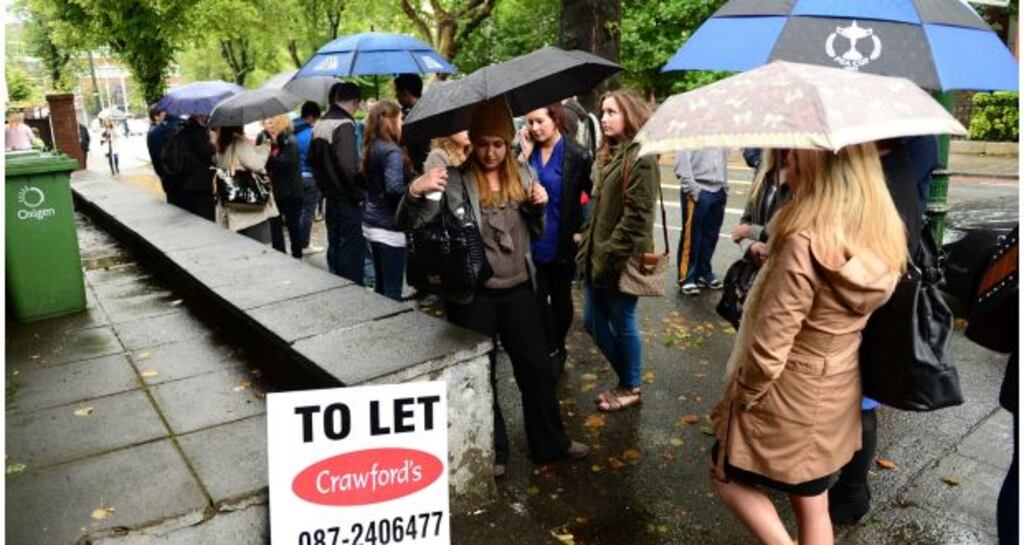How many times can we write about the renting crisis? How many times can we ask serious questions about the state of dereliction across Dublin in buildings where people could actually live without new homes being built? How many students are going to be panicking and stressed out when they arrive in the capital with nowhere to live?
How many people are standing in lines outside overpriced properties right now with scraped-together deposits in their pockets? How many people are crashing on their friend’s couches and floors? How many are still sleeping in their childhood bedrooms well into their 20s and 30s?
How could anyone rent if they only get €100 a week on the dole? How many housing plans favour developers? How many landlords are seizing the moment with cynicism and greed, packing people in like sardines or upping rents to upsettingly unattainable prices? And why are we still asking these questions when the crisis has been so apparent for so long?
Underclass
As usual, it’s the poor and young who are suffering the most: the unemployed, young families, young couples, single people and students. This is the struggling and largely invisible housing underclass, people whose don’t have the fallback of moving home, and so their options are homelessness, getting on stagnant housing lists or living in poor conditions.
Because tenants’ rights aren’t strong, because this massive group doesn’t lobby, they possess little political power. They take what they can get, and increasingly, what they can get is an absolute rip-off. With rents higher than at the peak of the Celtic Tiger, all the current and last governments’ efforts to solve the problem appear inadequate, slow, and uncaring.
Tiny apartments and endless queues are creating a bunk bed generation, where grown adults are offered the type of sleeping arrangements that most people retired along with their Teenage Mutant Ninja Turtles duvet covers. Landlords are turning properties into glorified hostels, stacking beds high to maximise profit.
Browsing through the appropriately named Daft property website is shocking and depressing. €300 a month for a spot in a bunk bed in a one-bedroom flat with four beds within arm’s reach of each other on Parnell Street; €450 a month for a single bed in a room of two single beds in a flat on Bolton Street; €950 a month for a room on Waterloo Road.
€320 for a single bed in a bedroom shared with two other people in Rathmines; €485 for a single bed in a shared bedroom in Rathmines; €440 a month for a spot in a bunk bed in a house that looks laden down with them in Portobello, which according to the photos seems to have one bedroom with two bunk bed sets, and another with three, which would earn the landlord €4,400 a month; €295 a month for a single bed in a room shared with two other people on Dorset Street.
The problem with “solutions” offered by Government is that they are piecemeal ones. There does not seem to be a cohesive joined-up plan that will genuinely tackle the crisis and fix the problem. As the Central Bank’s rules on mortgage-lending solidified, the reality struck that only rich people can buy houses in Ireland now.
Among non-rich young people, that means unless a parent or two gives you a dig out and a chunk – or all – of your deposit, you’re stuck in an increasingly dystopian private rental sector. Those who do not have a wealthy parent or parents are excluded from buying a home. That is just wrong.
By introducing another half-baked measure, the two-year rent control limit, landlords took the opportunity to increase rents before the rule came into effect. And what do you think will happen when those two years are up? It will offer landlords another window to increase rents again.
Rent has jumped 39 per cent since 2011, according to Ronan Lyons, who authored the most recent Daft report. Sure, some new student accommodation is being built, but it’s not available yet, and construction of student accommodation in Dublin should have begun decades ago.
Massive profits
Instead, developers and landlords were allowed build apartment developments that had nothing to do with people in cities who actually needed housing, and everything to do with making massive profits.
Supply is cited as the greatest problem again and again, but dereliction and vacancy is also a massive issue. The Urban Regeneration and Housing Act 2015 introduced the vacant site levy, but this won’t be payable until 2019 – another horse-has-bolted moment. An audit by Dublin City Council last year found 282 vacant or derelict sites in central Dublin - 61 hectares of land. That is nearly seven times the size of St Stephen’s Green park.
While renters struggle and queue, and get served notice so landlords can increase rent, while people desperately scroll through Daft and borrow money from friends and family, while housing lists creak and working people crawl into bunk beds, the reality is our government has never cared about renters, and the disjointed slow-motion scramble to address the crisis is too little too late.










